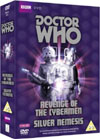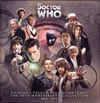DVD Extras include:
In this, the only Cyberman adventure of the 1970's, both the writing and the production are significantly rough around the edges, but the story does not shy away from attempting lots of action, special effects, exploration and advancement of the Cyber mythology, and it manages to keep up a tremendous pace throughout a host of excellent story beats.
Travel Loosens the LogicThe backstory to the adventure seems to keep contradicting itself. You can read the SPOILERS that prove this point in the In-depth Analysis version of this review. Maybe the questions that I raise about the backstory have good answers, but the script seems to ignore them, doing whatever it pleases to suit the scene at hand.The dialogue is also noticeably not great in many places. The opening scene in particular leaves much to be desired in being easily understandable to anyone who hasn't been following all of the Doctor's recent adventures. One good point is made well: that the main protagonists are looking for the TARDIS. I suspect that this could still well be lost on new (North American) viewers who started watching with Tom Baker's first story, since the TARDIS hasn't made much impression during his era yet, and hasn't appeared at all recently. The transmat is quite busy during this adventure, now becoming a staple Who device with a reliable and enjoyable special effect. The space station segments are quite reminiscent of previous Cyber adventures, with an isolated outpost of Humans battling illness and Cybermats. The only thing missing is a good round of coffee. The Cybermats are at their least effective in this story, and thankfully retired from TV appearances afterward. It is chiefly the exploration of the unknown element of the Voga planetoid that keeps the early parts of the story fresh.
Masking the VogansThe Vogan race is unique in Doctor Who, using full face masks to achieve a look that is not so wildly alien, but rather very Human, with a slightly different bone structure. The masks for each major Vogan character differentiate themselves really well also. But curiously enough, aliens such as the Vogans were not really attempted on the show after this; instead race after race of humanoid aliens will be played by actors with no special masks or make-up at all. What happened?This story has an excellent cast; in fact it's hard to find a name in the cast list who hasn't been in Doctor Who before or since. Of particular note, we've got Kevin Stoney, who mastered two brilliant lead villain roles in 1960's Doctor Who, the prolific Michael Wisher who did this story back-to-back with his classic portrayal of Davros, and up-and-coming David Collings who delivers a tour-de-force performance as Vorus here. But they're all Vogans with masks hiding their features and many of their expressions, and the script offers Tom Baker only one, sort-of-anticlimactic scene with the enormous talent playing the major Vogan characters. The political intrigue between the Vogan factions seems too repetitive in its offerings of dialogue, and too isolated from the rest of the story. Yes, it brings quite a bit of action too, but often when the story cuts from the main Cyber plot to the middle of a Vogan-vs.-Vogan shootout (particularly at the beginning of an episode), I find myself stopping and wondering why the Vogans are going at each other, not remembering how they got to that stage. Something about the Vogans just doesn't work. The Doctor spends far more time confronting Kellman and the Cybermen. Kellman seems far too obvious to last as long as he does. Jeremy Wilkin imbues him with an appropriate sleaziness, but puts an overly melodramatic level of acid into the delivery of many of his lines. And for a Cyber-Leader, the Doctor gets to confront the Karkus from "The Mind Robber" (story no. 45). Christopher Robbie's Cyber-Leader is almost as unique as the Vogans - he hasn't got the electronically emotionless tones of 1960's Cybermen, nor the deviously dark and dangerous tones of 1980's Cybermen. He's very Human, acting robotically, caught between the two in Karkus land. He still gets to exchange some classic lines with the Doctor, and he is enough of a Cyberman to be believable. Rounding out the Human cast are Ronald Leigh-Hunt of "The Seeds of Death" (story no. 48), William Marlowe of "The Mind of Evil" (story no. 56), and Alec Wallis of "The Sea Devils" (story no. 62), who all put in solid, underplayed performances that work well for the story. Harry Sullivan's experience in traveling through time and space begins to benefit him in this story. After the first episode, whenever he can get away from the Doctor, he is quite capable of taking charge, solving problems, and easing tensions among aliens. Unfortunately, the Doctor still gives him a hard time whenever he can, and appears to be unfair about it in this story.
This story features some very excellent location footage for many of the grander cave-interior sequences, giving Voga a reality that it could never have achieved in the studios alone. "Revenge of the Cybermen" saves its best for last: a very fast-paced, action-packed, effects-laden finish that does the story proud. Yes, we can nit-pick about how Voga seems to become a cylindrical planet instead of a spherical one as we fly around it, but the energy is right, and the effects are still neat. I like it. And the TARDIS makes its first proper materialization of the Tom Baker era. Things are looking up.
Season Twelve Rankings:Best Story:
"Revenge of the Cybermen" has become available on DVD and VHS video. Click on the Amazon symbol for the location nearest you for pricing and availability:
Comments on this article are welcome. You may contact the author from this page:
|











